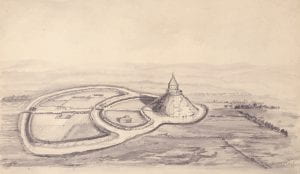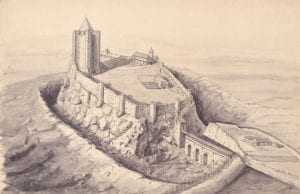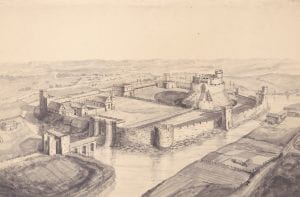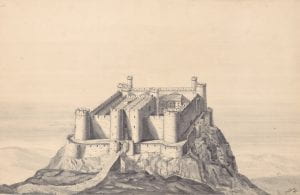Castle drawings by Charles Henry Ashdown
Castles, those formidable stone monoliths that dotted the countryside serving as homes and fortresses, form one of the most enduring images of the Middle Ages in Western Europe. While many now lie in varying states of ruin, few symbols of the medieval period capture the imagination of the modern person to such an extent. One envisions how they must have looked in the midst of their glory days, some eight hundred years ago.
Charles Henry Ashdown was an English illustrator who endeavoured to bring his visions of British castles, as they would have stood in the Middle Ages, to life. The writer of numerous books on medieval architecture and weaponry, his most notable works are British and Foreign Arms & Armour, published in 1909, and British Castles, published in 1911. Little is recorded about Ashdown’s life, although details given in the front pages of British and Foreign Arms, identify him as based in St. Albans, Hertfordshire, and working as the Curator of Numismatics at Herts County Museum. His book on British castles features 22-full colour illustrations along with detailed commentary on the history and function of castles. However, interestingly, none of these illustrations match up to a series of twelve pencil and watercolour drawings, completed by Ashdown from 1914-1921, that are held within the Baillieu Library Print Collection. Furthermore, these drawings seem to not be listed in the catalogues of any other major library, unlike Ashdown’s fairly ubiquitous book publications. Perhaps these are unpublished works of Ashdown’s, part of a more personal project, which somehow ended up in the hands of an individual who thought best to deposit them safely in the University collection on the other side of the world. While far away from Ashdown’s beloved St. Albans, and the medieval architecture which formed the inspiration for his art, his ability to envision and illustrate castles in their now lost form is one that can be appreciated from anywhere and any time.

Ongar Castle, Essex, is a 12th century motte and bailey castle that was occupied until the 16th century. The motte still stands at 50 feet high but is completely overgrown with wild greenery and the tower which sat upon it has been demolished. Ashdown’s drawing demonstrates how the motte (the hill with tower) and the bailey, (the area including farmland protected by the ring of water), would have looked. A source of producing food within the protection of the castle area reduced the risk that those within the castle would be starved out during a siege attack.

Conisbrough Castle, South Yorkshire, built in the 11th century, was acquired through marriage by the illegitimate son of Henry II, William Hamelin, and remained in his family line until 1461. The title of Ashdown’s print specifies that the castle is pictured as in 1190, which is approximately ten years after Hamelin had the motte converted into stone from the less robust wood. The same motte and bailey as design as Ongar Castle can be seen, except on a larger scale. Failing into disrepair the castle was not of use during the English Civil War, but it became known as a somewhat romantic ruin. Sir Walter Scott’s 1819 novel Ivanhoe is set in Conisbrough, following a fictional “Saxon” nobleman in his pursuits of love and glory. After some repairs in the 1990s to make the castle safe for the public, it is now operated by English Heritage as a tourist attraction.

Sheffield Castle, South Yorkshire, began as a Norman motte and bailey castle, possibly on the site of a previous Anglo-Saxon long house. Ashdown illustrates quite a substantial settlement, including numerous stone buildings within the bailey. These could have included a chapel and stables. A large moat with a drawbridge is shown, along with an impressive stone wall. While the site has existed since 1644 as ruins as it was razed by the Parliamentarians during the English Civil War, archaeological digs at the site support the design shown in the illustration. Arguably the most famous resident of Sheffield Castle is Mary, Queen of Scots, who was imprisoned there between 1570 and 1584, three years before her execution.

Harlech Castle, Gwynedd, was constructed by Edward I for his late 13th century invasion of North Wales. As can be seen in the Ashdown drawing, illustrating the castle in 1300, Harlech Castle is a later form of castle design than the older motte and bailey format. Known as the concentric design castle, a huge stone wall in a square shape with circular towers on each corner, along with D-shaped towers flanking the drawbridge, surrounded the inner ward area. Built onto Harlech Dome, a 200 feet tall sheer-sided spur of rock, the castle would have been extremely difficult to successfully siege. The castle was held by several years by the Lancastrians during the 15th-century Wars of the Roses, however was eventually claimed by the Yorkist troops in 1468, a significant win. It is now owned by Cadw, the Welsh historical environment service, and it open as a tourist attraction.
These four castles demonstrate the variety and wealth of history captured within Ashdown’s work. Although the specific origin of the twelve drawings is unknown, and details on Charles Henry Ashdown himself are unclear, they serve as wonderful resources to picture these castles as medieval people would have seen them, a vision that Ashdown, in his talent as an illustrator and his vigour for medieval history, brought to life for us to enjoy.
Adelaide Greig
Print Collection Intern
Categories
Leave a Reply